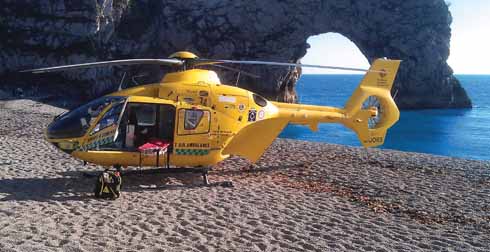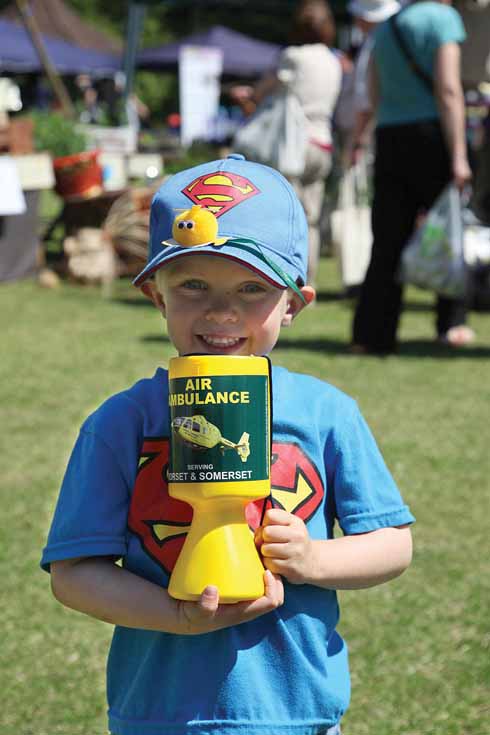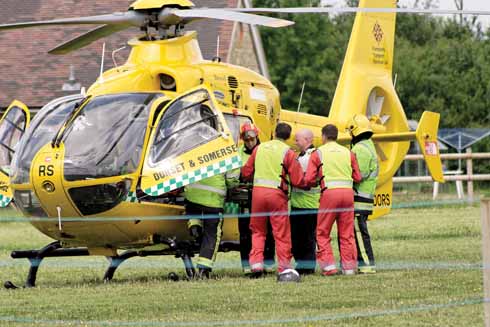Giving Dorset: Help from on high
As Dorset and Somerset's Air Ambulance enters its fifteenth year of operation, Rachel Gower finds out more about the organisation and its work
Published in March ’14
Within an hour of Dorset and Somerset’s air ambulance (DSAA) becoming operational in March 2000, it was on its way to its first emergency. Since then it has flown to almost 10,000 incidents and played its part in saving innumerable lives
The sensible decision had been taken early on for one service to cover the two counties; its base at Henstridge is within 200 yards of the county boundary, which is both politically tactful and operationally ideal, as it takes twelve minutes to fly to Swanage and nineteen to Exmoor.
DSAA’s Eurocopter EC135 can not only reach remote places inaccessible to a land ambulance, it moves faster, in a straight line and is unencumbered by narrow country lanes or urban traffic jams. Another crucial difference is the specialist skills of the airborne paramedics in dealing with trauma cases, of which they see six times as many as their land-based colleagues. Trauma can be defined as ‘serious, life-threatening injuries calling for quick management and transport to an appropriate facility’. Its recognition as a sub-division within emergency medicine is reflected in the nomination of certain hospitals as major trauma centres, but there are only three in the South-West: Plymouth, Bristol and Southampton.
The South Western Ambulance Service NHS Foundation Trust (SWASfT) serves a huge area including Bristol, Cornwall, Devon, Dorset, Somerset, Wiltshire and South Gloucestershire; emergency calls for the south of the area come into a control room in Exeter, which includes a specialised HEMS (Helicopter Emergency Medical Service) desk with a sophisticated GPS-based technology which enables a dispatcher to pinpoint an incident.
If the dispatcher decides that it is a suitable task for the Dorset and Somerset helicopter (one of five in the SWASfT area), a phone rings at the Henstridge base. One of the two paramedics on duty alerts the pilot, who prepares the aircraft while the paramedic plans the mission. Within three minutes of the call being received, the helicopter is in the air and on its way. As land ambulances rely on postcodes, DSAA has worked closely with a manufacturer of aviation navigation equipment to develop a system that allows postcodes to be used in the air; four other counties have now taken up the system.
The helicopter is owned and operated by Bond Aviation, who also provide the pilots, engineers, maintenance and spares on a long-term contract. They have been involved since the beginning, but back then, the air ambulance was on such a tight budget that the arrangement was renewed weekly! The two regular pilots are Max Hoskins, who has had long experience flying to North Sea oil-rigs, and former RAF helicopter and test pilot Phil Merritt.
There are six paramedics and a number of relief paramedics, all of whom have been specially trained for their particular role. DSAA took the far-sighted decision to develop that training and has set up a pioneering scheme with the University of Hertfordshire which will lead to its paramedics having the chance to earn an MSc in Advanced Paramedic Practice (Critical Care). The university has accredited local doctors and other health professionals to act as tutors and mentors. Some of the doctors are already involved with the air ambulance and fly with it, including Mr Chowdhury Farhad Islam, Consultant in Emergency Medicine at Royal Bournemouth Hospital, who was recently shortlisted for the Air Ambulance Doctor of the Year award. He played a leading part in setting up the new course and sums up its purpose: ‘The paramedics will enhance their patient assessment skills, gain a wider knowledge of drugs, improve their diagnostic abilities, advance their management of pain and become better at clinical decision-making.’
DSAA’s paramedics are employees of SWASfT, who are also responsible for the day-to-day medical supplies, but the air ambulance is a fully independent charity that receives no direct funding from the public purse. Its £2.8 million annual running cost is raised by extremely effective fund-raising, especially the ‘Flight for Life’ lottery, which is by far the most important source of revenue. It is one of the most successful specialised lotteries in the country, and Bill Sivewright, who has been the charity’s CEO for three years, is convinced of the benefits of running it in-house rather than delegating it to a third party.
Bill is an ex-Army pilot who served with Joint Helicopter Command. He favours community-based activities over corporate sponsorship or approaches to grant-giving bodies. ‘The sort of fund-raising we do reflects how well we are regarded by those we are here to serve,’ he says. ‘We are a community charity and I never want to lose sight of what you could call the widow’s mite. Although we might go after grants for capital projects, if a charity can’t raise the funds it needs to operate day-to-day, then it’s in trouble.’ Bill gives full credit to the efforts of volunteers throughout the two counties without whom the operating funds simply would not materialise.
So effective have those efforts been that the charity has built up enough reserves to fund the purchase of a new larger helicopter capable of carrying more equipment, which, although still operated by Bond Aviation, would be owned outright by the charity.
The air ambulance is currently on call 365 days a year, twelve hours a day in the summer and during daylight in winter. Next year, the winter availability may also be extended to twelve hours, through the use of fixed landing sites to which patients would be brought by land ambulance. Night flying involving landing directly at the sites of incidents (balancing the increased risks against whatever gain there might be in patient benefit) is also being considered for the future. One thing is certain: if it can reasonably be done, it will be done, so strong is the sense of service within Dorset and Somerset Air Ambulance. That sense is perfectly summed up in their slogan which is as thought-provoking as it is accurate:
‘We save lives; one day it could be yours.’ ◗
❱ www.dsairambulance.org.uk





